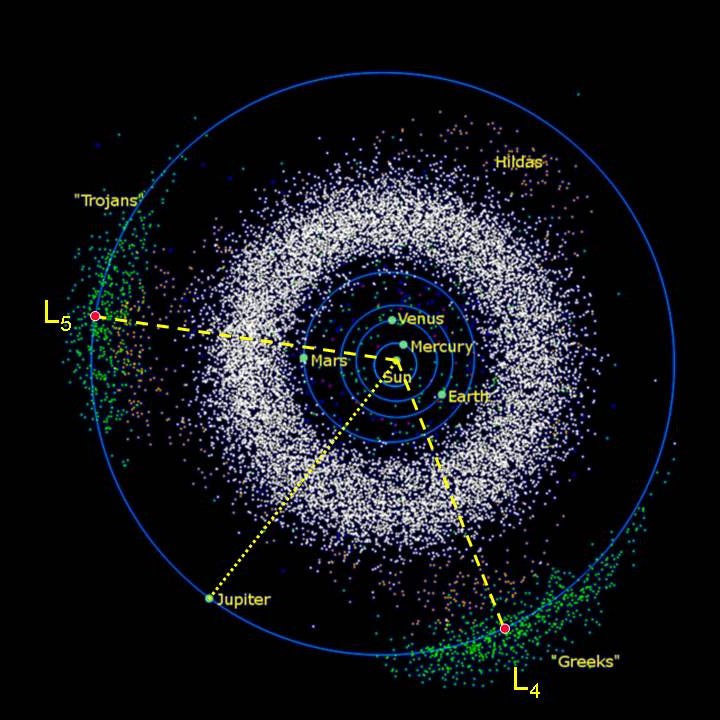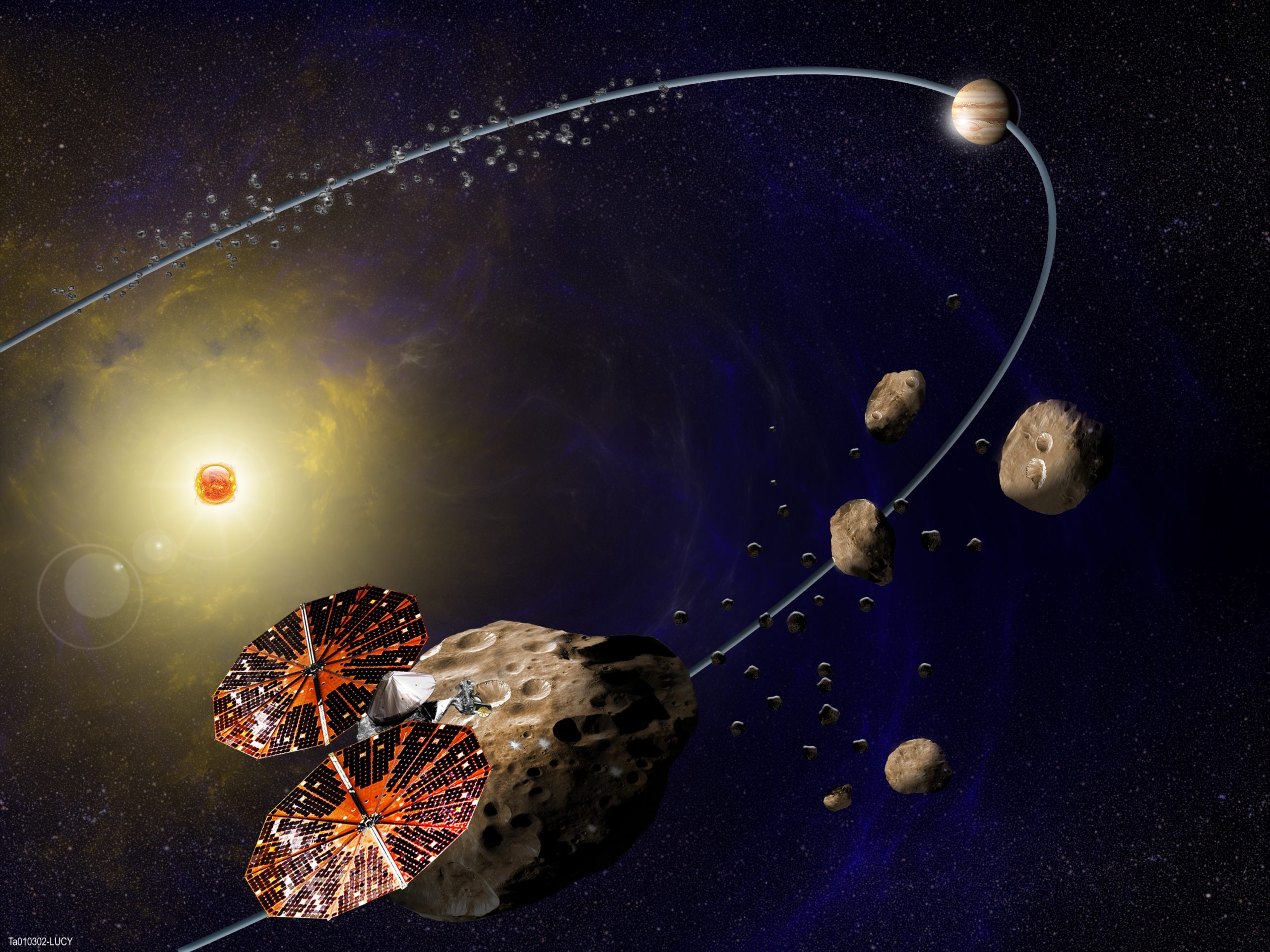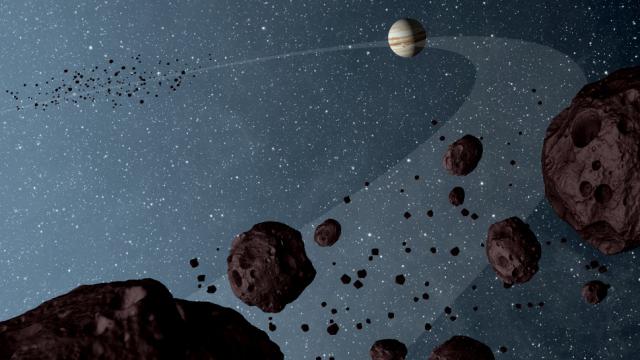In addition to its 67 moons, Jupiter is accompanied by two giant clusters of asteroids that orbit the Sun along the same path, and is packed with as many large objects as the Asteroid Belt. Yesterday, NASA announced a new mission to investigate these “trojan” asteroids. Here’s what you need to know about this exciting new project.
Artist’s impression of the Jovian Trojans (not to scale). (Image: NASA/JPL-Caltech)
NASA announced two new space missions yesterday as part of its Discovery Program. Named Psyche and Lucy, these projects will deploy spacecraft to investigate asteroids, but the missions themselves are quite distinct. The Psyche space probe will visit a giant metal asteroid in 2030, and Lucy will investigate a half-dozen Trojan asteroids along Jupiter’s orbital plane from 2027 to 2033. By exploring the Jovian Trojans, scientists will gain a better understanding of these objects and how they got caught in Jupiter’s gravitational field, while also learning more about the chemical composition of the early solar system.
Mars, Neptune and Earth have their own trojan objects, but Jupiter has a trojan swarm unlike any other. Known as the Jovian Trojans, they are organised into two giant clumps — one in front of the gas giant and one that trails behind. These two clusters join Jupiter during their 12-year journey around the Sun, forever trapped by the gas giant’s gravitational influence.
In astronomy, a trojan is any object, such as an asteroid, minor planet or small moon, that tracks the orbit of a larger object, such as a planet or a large moon. Trojan objects are located at two of Jupiter’s so-called Lagrangian points — L4 and L5 — which are sweet spots in space where the combined gravity of two objects balance out the centrifugal force felt by a much smaller third body. In the case of the Jovian Trojans, the two larger objects are Jupiter and the Sun.

Shown in green, the Jovian Trojans are divided into two clusters — the “Greeks” out front, and the “Trojans” trailing behind. (Image: Ohio State University).
Named after the famous fossil skeleton of an early human ancestor, the Lucy mission is scheduled for launch in 2021 (the probe is named in honour of Lucy because it’s going to investigate a collection of primordial asteroids). Lucy will travel through the asteroid belt in 2025, where it will make a scheduled visit to a 4km-wide asteroid called 52246 Donaldjohanson (named for the discoverer of the Lucy fossil, Donald Johanson).
The spacecraft will finally reach the Jovian system in 2027 — or more accurately, it will arrive within Jupiter’s vast orbital plane. Lucy will never get anywhere near Jupiter during this mission, instead investigating at least six Trojan asteroids caught in Jupiter’s vast orbit, including a front-pack object named Eurybates.
“This is a unique opportunity,” noted Lucy mission scientist Harold F. Levison in a NASA statement. “Because the Trojans are remnants of the primordial material that formed the outer planets, they hold vital clues to deciphering the history of the solar system.”
For its mission, Lucy will be equipped with updated versions of the RALPH and LORRI science instruments, which are also found on the New Horizons probe; these imagers will serve as Lucy’s “eyes”, taking thermal scans and snapping infrared and visible light images. The mission will also benefit from the experience gleaned during the OSIRIS-REx mission to asteroid Bennu, adopting the project’s OTES instrument and several project team members (several New Horizons members will also be joining the team). A thermal emission spectrometer developed by Arizona State University will allow the probe to measure the surface temperatures of each asteroid. Lucy will also use its telecommunications system to determine the masses and densities of the Trojan targets.
“Understanding the causes of the differences between the Trojans will provide unique and critical knowledge of planetary origins, the source of volatiles [chemicals like nitrogen, water, carbon dioxide and hydrogen] and organics on the terrestrial planets, and the evolution of the planetary system as a whole,” said Catherine Olkin, the mission’s deputy principal investigator.
Equipped with these observational instruments, Lucy will investigate at least six of Jupiter’s Trojans. Like main-belt asteroids, Jupiter’s Trojans form families, so Lucy won’t have to travel far to visit nearby objects. That said, NASA would like to visit distinctive asteroids.

Artist’s impression of the Lucy Mission (not to scale). (Image: Southwest Research Institute)
Not much is known about the Jovian Trojans. The first one was discovered by German astronomer Max Wolf in 1906, who confirmed the presence of a 350km-wide object leading ahead of Jupiter. Dubbed “Achilles”, it would be the first of many asteroids found within Jupiter’s orbit. Later surveys revealed the trailing pack, which is smaller than the leading one.
Until recently, astronomers simply knew that Jupiter was accompanied by two large clusters of asteroids. In 2012, astronomers used NASA’s Wide-field Infrared Survey Explorer (WISE) to view the asteroids in greater detail, revealing the presence of individual objects. Both packs of Trojans consist of predominantly of dark, reddish rocks with a matte, non-reflecting surface. Over 6000 Jupiter trojans have been documented by astronomers, but the total number of objects larger than 1km could be as high as one million. That’s about the same number of 1km-wide asteroids in the entire asteroid belt.
The sheer number of rocks means they likely came from outside the Jovian system. They have probably been around since the early days of the solar system when Jupiter was still forming. They don’t resemble the asteroids from the main belt between Mars and Jupiter, nor do they resemble Kuiper Belt objects located at the icy, outer regions beyond Pluto. They look like D-type asteroids — objects that feature a dark burgundy colour and comprise some of the oldest material in the solar system. These objects were likely captured into their orbits during the earliest days of the solar system, or later when the giant planets migrated inwards.
“Jupiter and Saturn are in calm, stable orbits today, but in their past, they rumbled around and disrupted any asteroids that were in orbit with these planets,” said WISE scientist Tommy Grav back in 2012. “Later, Jupiter re-captured the Trojan asteroids, but we don’t know where they came from. Our results suggest they may have been captured locally. If so, that’s exciting because it means these asteroids could be made of primordial material from this particular part of the solar system, something we don’t know much about.”
The Lucy mission is important, not least because the Jovian Trojans are difficult to observe from Earth. One cluster is predominantly in our planet’s northern sky, while the other is in the southern, forcing ground-based observers to use at least two different telescopes. This is not a huge problem, but it does present complications when comparing results from two different instruments, and typically at different times of the year.
With Lucy getting all up the Trojans’ business, we’ll have our first close-up view of these asteroids, and we’ll be able to confirm their chemical and compositional makeup. This mission will help us understand the early days of the solar system, and how Jupiter played a role in its development. Let the countdown begin to launch in 2021!
